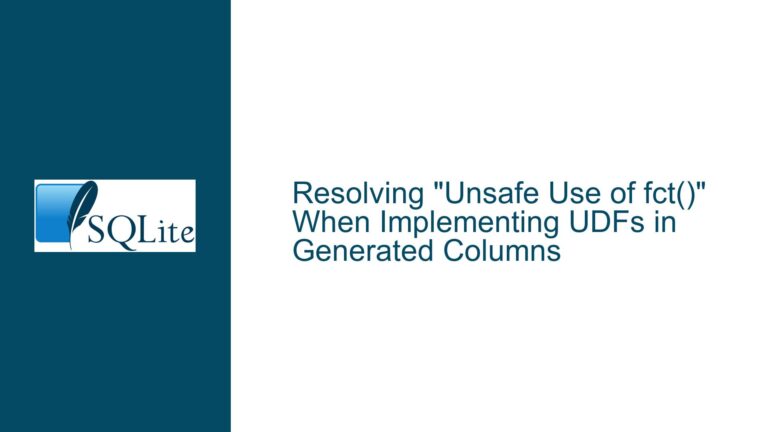Implementing Immutable Columns in SQLite Using Triggers
Immutable Columns: The Need for Write-Once, Read-Many Semantics
In database design, there are scenarios where certain columns should be immutable after their initial insertion. These columns, often referred to as "constant" columns, are designed to hold values that should not change once they are set. This requirement is common in use cases such as audit logs, historical records, or any situation where data integrity and consistency are paramount. For instance, a column storing a user’s registration date or a transaction ID should remain unchanged throughout the lifecycle of the record. SQLite, being a lightweight and versatile database, does not natively support the concept of immutable columns. However, this limitation can be effectively addressed through the use of triggers, which provide a mechanism to enforce such constraints programmatically.
The need for immutable columns arises from the desire to maintain data integrity and prevent accidental or malicious modifications. In a typical database schema, columns can be updated using the UPDATE statement, which can lead to unintended changes if not properly controlled. While SQLite offers constraints like UNIQUE and NOT NULL, these do not provide the level of control needed to enforce immutability. This is where triggers come into play. By defining a trigger that fires before an update operation, you can effectively prevent modifications to specific columns, thereby achieving the desired immutability.
Consider a scenario where you have a table named user_registrations with a column registration_date. This column should only be set once when the record is inserted and should never be updated thereafter. Without a mechanism to enforce this rule, there is a risk that the registration_date could be inadvertently or intentionally modified, leading to data inconsistencies. By implementing a trigger, you can ensure that any attempt to update the registration_date column will be aborted, thus preserving the integrity of the data.
Trigger-Based Enforcement of Column Immutability
The core mechanism for enforcing immutability in SQLite is the use of BEFORE UPDATE triggers. A trigger is a database object that automatically executes a specified set of actions in response to certain events, such as an UPDATE operation. In the context of immutable columns, a BEFORE UPDATE trigger can be defined to intercept any attempt to modify the column and raise an error, effectively preventing the update from occurring.
The syntax for creating such a trigger is straightforward. You define the trigger to fire before an update on the target column, and within the trigger body, you use the RAISE function to abort the operation and return an error message. Here is a generic example of how to create a trigger to enforce immutability on a column:
CREATE TRIGGER trigger_name BEFORE UPDATE OF column_name ON table_name
BEGIN
SELECT RAISE(ABORT, 'Updating table_name.column_name is prohibited');
END;
In this example, trigger_name is the name of the trigger, column_name is the name of the column that should be immutable, and table_name is the name of the table containing the column. When an UPDATE statement attempts to modify column_name, the trigger will fire, and the RAISE function will abort the operation, returning the specified error message.
To illustrate this with a concrete example, consider a table named transactions with a column transaction_id that should be immutable. The following SQL statements create the table and the corresponding trigger:
CREATE TABLE transactions (
transaction_id INTEGER PRIMARY KEY,
amount REAL NOT NULL,
transaction_date TEXT NOT NULL
);
CREATE TRIGGER prevent_transaction_id_update BEFORE UPDATE OF transaction_id ON transactions
BEGIN
SELECT RAISE(ABORT, 'Updating transactions.transaction_id is prohibited');
END;
With this trigger in place, any attempt to update the transaction_id column will result in an error, ensuring that the column remains immutable after its initial insertion.
Implementing and Validating Immutable Columns in SQLite
Implementing immutable columns in SQLite involves not only creating the necessary triggers but also validating that they function as intended. This process includes testing the behavior of the triggers under various conditions to ensure that they correctly prevent updates to the target columns while allowing other operations to proceed normally.
To begin, let’s consider a more comprehensive example involving a table named employee_records with a column employee_id that should be immutable. The following SQL statements create the table and the corresponding trigger:
CREATE TABLE employee_records (
employee_id INTEGER PRIMARY KEY,
name TEXT NOT NULL,
department TEXT NOT NULL,
hire_date TEXT NOT NULL
);
CREATE TRIGGER prevent_employee_id_update BEFORE UPDATE OF employee_id ON employee_records
BEGIN
SELECT RAISE(ABORT, 'Updating employee_records.employee_id is prohibited');
END;
With this setup, any attempt to update the employee_id column will be blocked by the trigger. For example, the following UPDATE statement will fail:
UPDATE employee_records SET employee_id = 2 WHERE employee_id = 1;
This statement will result in an error message: Updating employee_records.employee_id is prohibited. However, other columns in the table can still be updated without any issues. For instance, the following UPDATE statement will succeed:
UPDATE employee_records SET department = 'Engineering' WHERE employee_id = 1;
This demonstrates that the trigger only prevents updates to the employee_id column, allowing other columns to be modified as needed.
To further validate the behavior of the trigger, you can perform a series of tests to ensure that it behaves as expected under different conditions. For example, you can attempt to update the employee_id column using different WHERE clauses, or try to update multiple columns at once, including the employee_id column. In all cases, the trigger should prevent any updates to the employee_id column while allowing other updates to proceed.
In addition to testing the trigger’s behavior, it is also important to consider the impact of the trigger on database performance. While triggers can be a powerful tool for enforcing constraints, they do introduce additional overhead, as the database must execute the trigger logic for each relevant operation. In most cases, the performance impact of a simple BEFORE UPDATE trigger like the one described here will be negligible. However, in high-throughput environments or with more complex trigger logic, it is important to monitor performance and optimize as needed.
Another consideration is the maintenance of triggers over time. As the database schema evolves, you may need to modify or remove triggers to accommodate changes in the data model. It is important to document the purpose and behavior of each trigger, and to ensure that any changes to triggers are carefully tested to avoid unintended side effects.
In summary, implementing immutable columns in SQLite using triggers is a powerful technique for enforcing data integrity and preventing unintended modifications. By creating BEFORE UPDATE triggers that raise an error when an attempt is made to update a specific column, you can effectively enforce immutability for that column. This approach is flexible, easy to implement, and can be tailored to meet the specific needs of your application. However, it is important to thoroughly test and validate the behavior of the triggers, and to consider the impact on database performance and maintenance over time.






